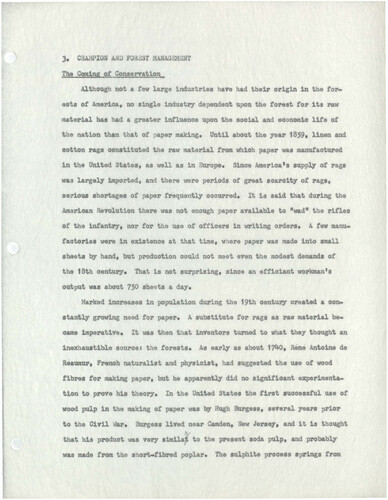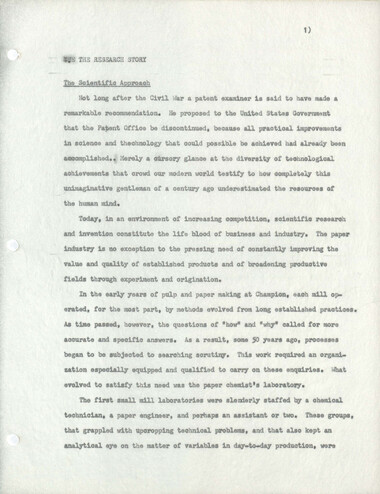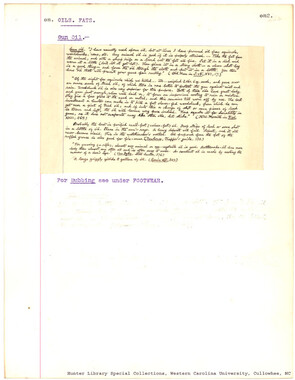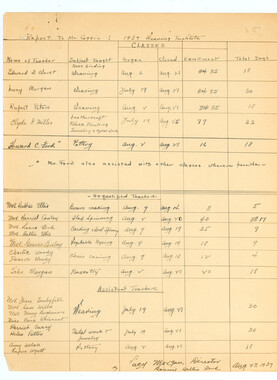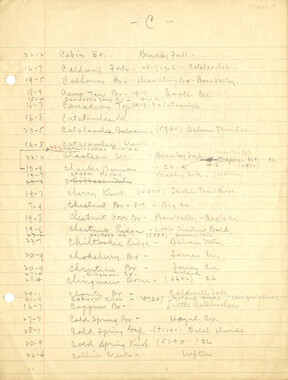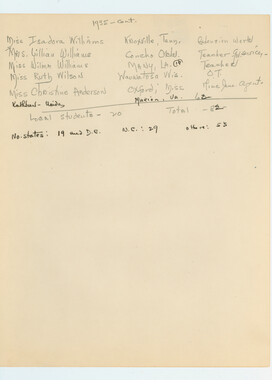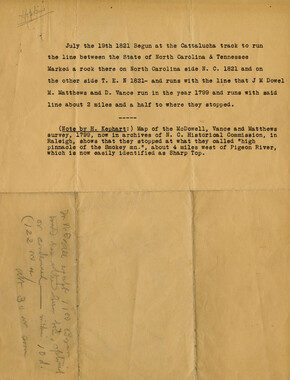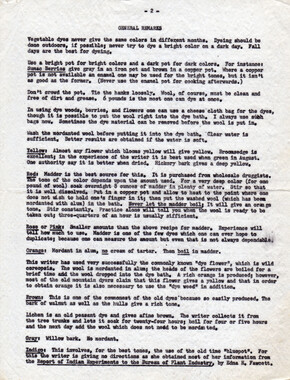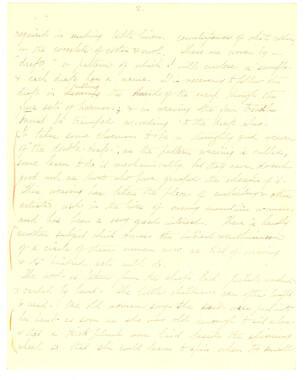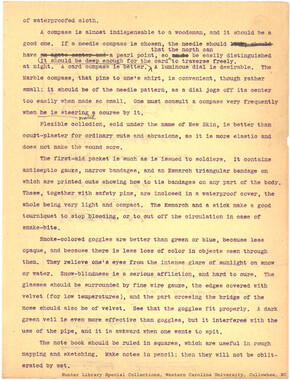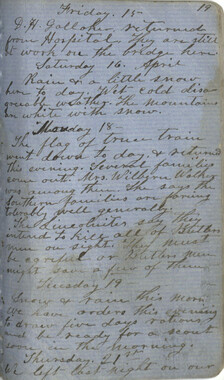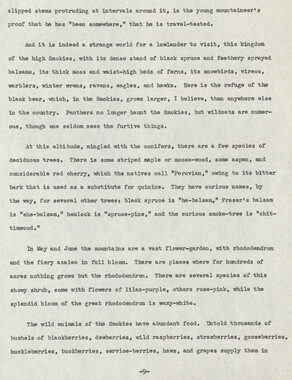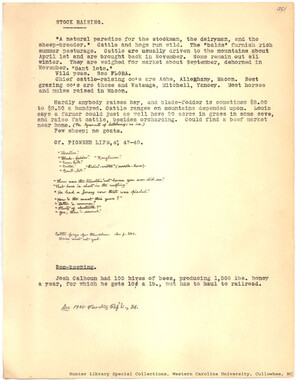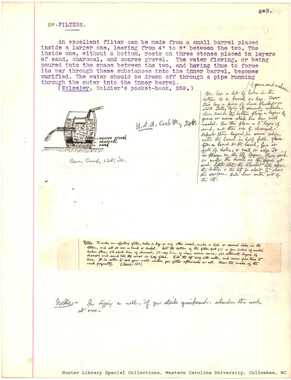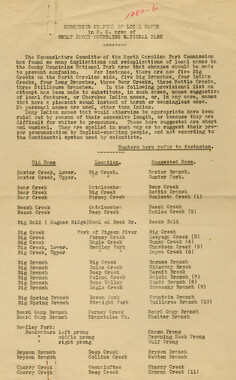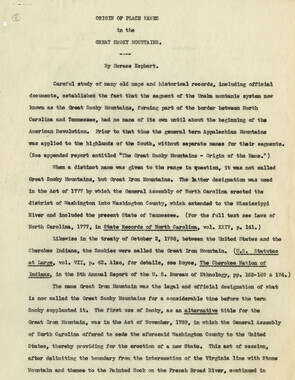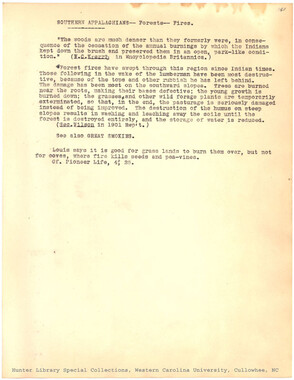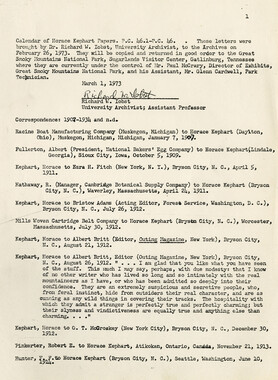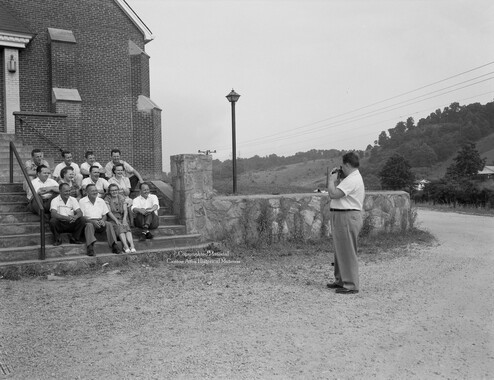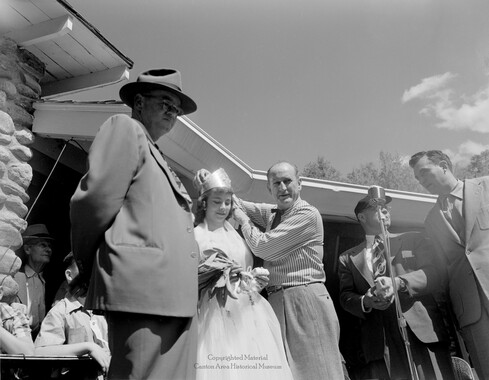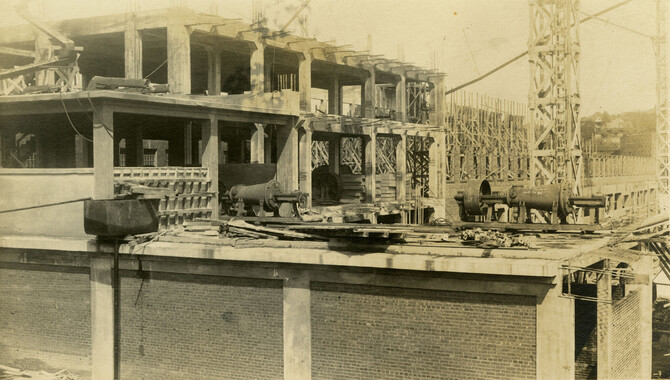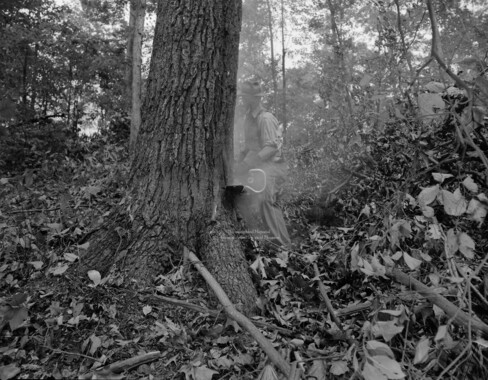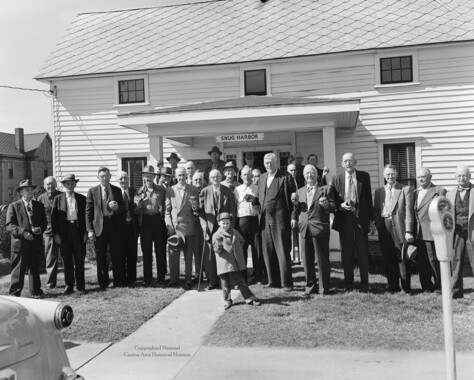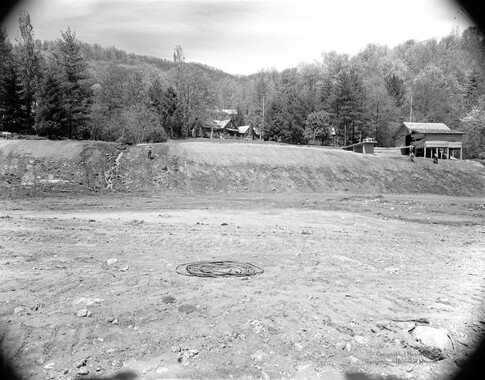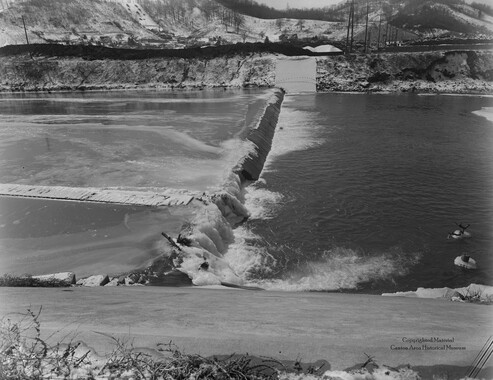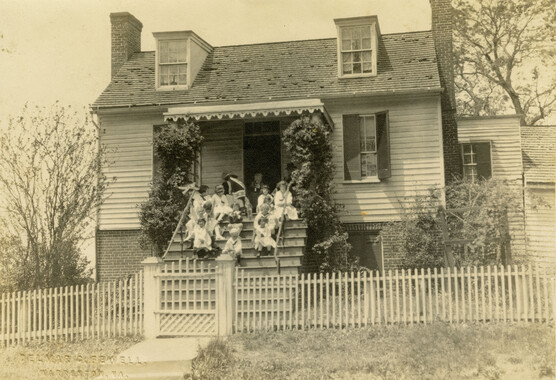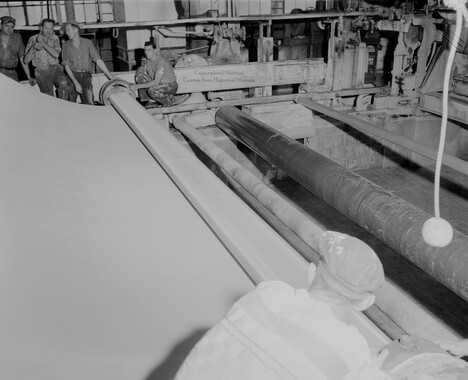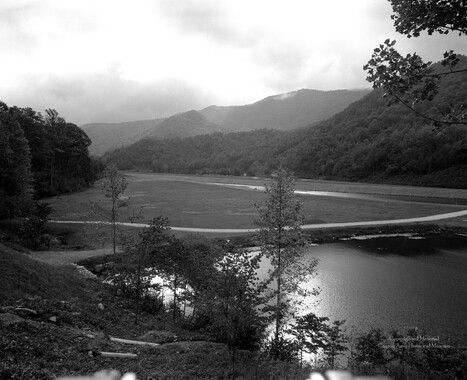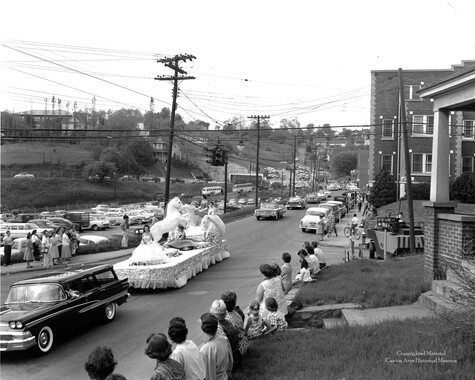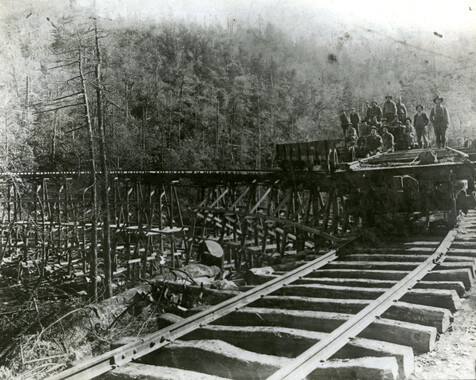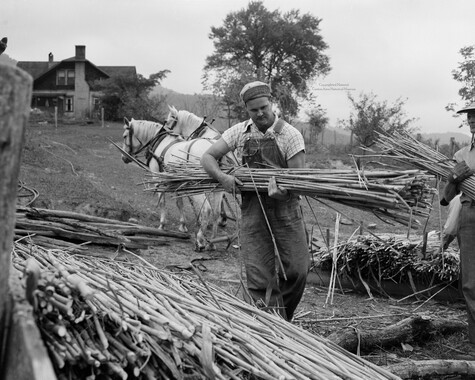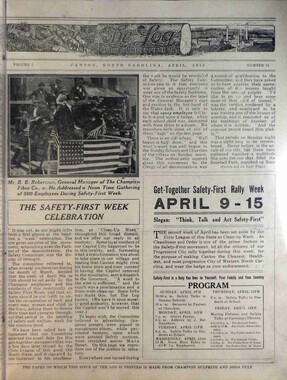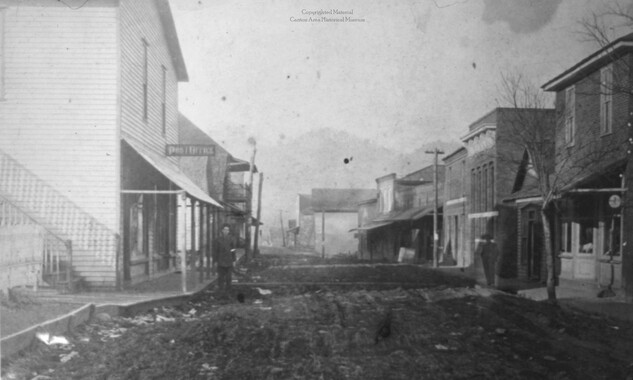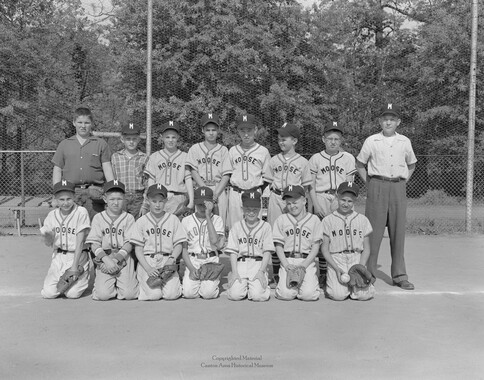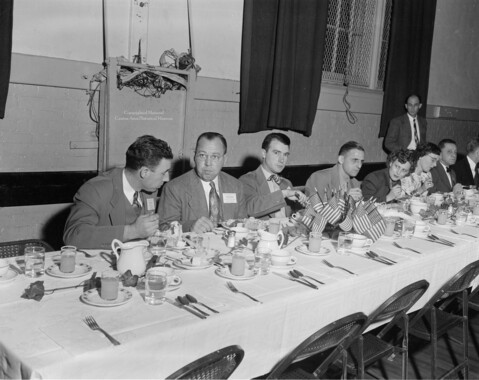Western Carolina University (21)
View all
- Canton Champion Fibre Company (2308)
- Cherokee Traditions (291)
- Civil War in Southern Appalachia (165)
- Craft Revival (1942)
- George Masa Collection (137)
- Great Smoky Mountains - A Park for America (2900)
- Highlights from Western Carolina University (422)
- Horace Kephart (941)
- Journeys Through Jackson (159)
- LGBTQIA+ Archive of Jackson County (85)
- Oral Histories of Western North Carolina (314)
- Picturing Appalachia (6797)
- Stories of Mountain Folk (413)
- Travel Western North Carolina (153)
- Western Carolina University Fine Art Museum Vitreograph Collection (129)
- Western Carolina University Herbarium (92)
- Western Carolina University: Making Memories (738)
- Western Carolina University Publications (2491)
- Western Carolina University Restricted Electronic Theses and Dissertations (146)
- Western North Carolina Regional Maps (71)
- World War II in Southern Appalachia (131)
University of North Carolina Asheville (6)
View all
- Allanstand Cottage Industries (62)
- Appalachian National Park Association (53)
- Bennett, Kelly, 1890-1974 (1463)
- Berry, Walter (76)
- Brasstown Carvers (40)
- Carver, George Washington, 1864?-1943 (26)
- Cathey, Joseph, 1803-1874 (1)
- Champion Fibre Company (233)
- Champion Paper and Fibre Company (297)
- Cherokee Indian Fair Association (16)
- Cherokee Language Program (22)
- Crowe, Amanda (40)
- Edmonston, Thomas Benton, 1842-1907 (7)
- Ensley, A. L. (Abraham Lincoln), 1865-1948 (275)
- Fromer, Irving Rhodes, 1913-1994 (70)
- George Butz (BFS 1907) (46)
- Goodrich, Frances Louisa (120)
- Grant, George Alexander, 1891-1964 (96)
- Heard, Marian Gladys (60)
- Kephart, Calvin, 1883-1969 (15)
- Kephart, Horace, 1862-1931 (313)
- Kephart, Laura, 1862-1954 (39)
- Laney, Gideon Thomas, 1889-1976 (439)
- Masa, George, 1881-1933 (61)
- McElhinney, William Julian, 1896-1953 (44)
- Niggli, Josephina, 1910-1983 (10)
- North Carolina Park Commission (105)
- Osborne, Kezia Stradley (9)
- Owens, Samuel Robert, 1918-1995 (11)
- Penland Weavers and Potters (36)
- Roberts, Vivienne (15)
- Roth, Albert, 1890-1974 (142)
- Schenck, Carl Alwin, 1868-1955 (1)
- Sherrill's Photography Studio (2565)
- Southern Highland Handicraft Guild (127)
- Southern Highlanders, Inc. (71)
- Stalcup, Jesse Bryson (46)
- Stearns, I. K. (213)
- Thompson, James Edward, 1880-1976 (226)
- United States. Indian Arts and Crafts Board (130)
- USFS (683)
- Vance, Zebulon Baird, 1830-1894 (1)
- Weaver, Zebulon, 1872-1948 (58)
- Western Carolina College (230)
- Western Carolina Teachers College (282)
- Western Carolina University (2008)
- Western Carolina University. Mountain Heritage Center (18)
- Whitman, Walt, 1819-1892 (10)
- Wilburn, Hiram Coleman, 1880-1967 (73)
- Williams, Isadora (3)
- Cain, Doreyl Ammons (0)
- Crittenden, Lorraine (0)
- Rhodes, Judy (0)
- Smith, Edward Clark (0)
- Appalachian Region, Southern (2940)
- Asheville (N.C.) (1944)
- Avery County (N.C.) (26)
- Blount County (Tenn.) (195)
- Buncombe County (N.C.) (1680)
- Cherokee County (N.C.) (283)
- Clay County (N.C.) (556)
- Graham County (N.C.) (238)
- Great Smoky Mountains National Park (N.C. and Tenn.) (525)
- Haywood County (N.C.) (3571)
- Henderson County (N.C.) (70)
- Jackson County (N.C.) (4919)
- Knox County (Tenn.) (35)
- Knoxville (Tenn.) (13)
- Lake Santeetlah (N.C.) (10)
- Macon County (N.C.) (421)
- Madison County (N.C.) (216)
- McDowell County (N.C.) (39)
- Mitchell County (N.C.) (135)
- Polk County (N.C.) (35)
- Qualla Boundary (982)
- Rutherford County (N.C.) (78)
- Swain County (N.C.) (2185)
- Transylvania County (N.C.) (270)
- Watauga County (N.C.) (12)
- Waynesville (N.C.) (86)
- Yancey County (N.C.) (72)
- Aerial Photographs (3)
- Aerial Views (60)
- Albums (books) (4)
- Articles (1)
- Artifacts (object Genre) (228)
- Bibliographies (1)
- Biography (general Genre) (2)
- Cards (information Artifacts) (38)
- Clippings (information Artifacts) (191)
- Copybooks (instructional Materials) (3)
- Crafts (art Genres) (622)
- Depictions (visual Works) (21)
- Design Drawings (1)
- Drawings (visual Works) (185)
- Envelopes (73)
- Exhibitions (events) (1)
- Facsimiles (reproductions) (1)
- Fiction (general Genre) (4)
- Financial Records (12)
- Fliers (printed Matter) (67)
- Glass Plate Negatives (381)
- Guidebooks (2)
- Internegatives (10)
- Interviews (815)
- Land Surveys (102)
- Letters (correspondence) (1013)
- Manuscripts (documents) (618)
- Maps (documents) (177)
- Memorandums (25)
- Minutes (administrative Records) (59)
- Negatives (photographs) (6090)
- Newsletters (1290)
- Newspapers (2)
- Notebooks (8)
- Occupation Currency (1)
- Paintings (visual Works) (1)
- Pen And Ink Drawings (1)
- Periodicals (193)
- Personal Narratives (10)
- Photographs (12976)
- Plans (maps) (1)
- Poetry (5)
- Portraits (4568)
- Postcards (329)
- Programs (documents) (181)
- Publications (documents) (2443)
- Questionnaires (65)
- Relief Prints (26)
- Sayings (literary Genre) (1)
- Scrapbooks (282)
- Sheet Music (2)
- Slides (photographs) (402)
- Songs (musical Compositions) (2)
- Sound Recordings (796)
- Specimens (92)
- Speeches (documents) (18)
- Tintypes (photographs) (8)
- Transcripts (322)
- Video Recordings (physical Artifacts) (23)
- Text Messages (0)
- A.L. Ensley Collection (275)
- Appalachian Industrial School Records (7)
- Appalachian National Park Association Records (336)
- Axley-Meroney Collection (2)
- Bayard Wootten Photograph Collection (20)
- Bethel Rural Community Organization Collection (7)
- Blumer Collection (5)
- C.W. Slagle Collection (20)
- Canton Area Historical Museum (2110)
- Carlos C. Campbell Collection (462)
- Cataloochee History Project (64)
- Cherokee Studies Collection (4)
- Daisy Dame Photograph Album (5)
- Daniel Boone VI Collection (1)
- Doris Ulmann Photograph Collection (112)
- Elizabeth H. Lasley Collection (1)
- Elizabeth Woolworth Szold Fleharty Collection (4)
- Frank Fry Collection (95)
- George Masa Collection (173)
- Gideon Laney Collection (452)
- Hazel Scarborough Collection (2)
- Hiram C. Wilburn Papers (28)
- Historic Photographs Collection (236)
- Horace Kephart Collection (861)
- Humbard Collection (33)
- Hunter and Weaver Families Collection (1)
- I. D. Blumenthal Collection (4)
- Isadora Williams Collection (4)
- Jesse Bryson Stalcup Collection (47)
- Jim Thompson Collection (224)
- John B. Battle Collection (7)
- John C. Campbell Folk School Records (80)
- John Parris Collection (6)
- Judaculla Rock project (2)
- Kelly Bennett Collection (1482)
- Love Family Papers (11)
- Major Wiley Parris Civil War Letters (3)
- Map Collection (12)
- McFee-Misemer Civil War Letters (34)
- Mountain Heritage Center Collection (4)
- Norburn - Robertson - Thomson Families Collection (44)
- Pauline Hood Collection (7)
- Pre-Guild Collection (2)
- Qualla Arts and Crafts Mutual Collection (12)
- R.A. Romanes Collection (681)
- Rosser H. Taylor Collection (1)
- Samuel Robert Owens Collection (94)
- Sara Madison Collection (144)
- Sherrill Studio Photo Collection (2558)
- Smoky Mountains Hiking Club Collection (616)
- Stories of Mountain Folk - Radio Programs (374)
- The Reporter, Western Carolina University (510)
- Venoy and Elizabeth Reed Collection (16)
- WCU Gender and Sexuality Oral History Project (32)
- WCU Mountain Heritage Center Oral Histories (25)
- WCU Oral History Collection - Mountain People, Mountain Lives (71)
- WCU Students Newspapers Collection (1923)
- Western North Carolina Tomorrow Black Oral History Project (69)
- William Williams Stringfield Collection (2)
- Zebulon Weaver Collection (109)
- African Americans (390)
- Appalachian Trail (35)
- Artisans (521)
- Cherokee art (84)
- Cherokee artists -- North Carolina (10)
- Cherokee language (21)
- Cherokee pottery (101)
- Cherokee women (208)
- Church buildings (190)
- Civilian Conservation Corps (U.S.) (111)
- College student newspapers and periodicals (2012)
- Dams (108)
- Dance (1023)
- Education (222)
- Floods (61)
- Folk music (1015)
- Forced removal, 1813-1903 (2)
- Forest conservation (220)
- Forests and forestry (1197)
- Gender nonconformity (4)
- Great Smoky Mountains National Park (N.C. and Tenn.) (181)
- Hunting (46)
- Landscape photography (25)
- Logging (119)
- Maps (83)
- Mines and mineral resources (9)
- North Carolina -- Maps (18)
- Paper industry (38)
- Postcards (255)
- Pottery (135)
- Railroad trains (72)
- Rural electrification -- North Carolina, Western (3)
- School integration -- Southern States (2)
- Segregation -- North Carolina, Western (5)
- Slavery (5)
- Sports (452)
- Storytelling (243)
- Waterfalls -- Great Smoky Mountains (N.C. and Tenn.) (66)
- Weaving -- Appalachian Region, Southern (280)
- Wood-carving -- Appalachian Region, Southern (328)
- World War, 1939-1945 (173)
A History of Champion Papers, Chapter 3, Champion and Forest Management
Item
Item’s are ‘child’ level descriptions to ‘parent’ objects, (e.g. one page of a whole book).
-
Chapter three of Corydon Bell's 1963 history of Champion Papers covers forest management. This 33 page chapter begins with the history of using wood pulp to make paper, and continues with the evolution how America viewed its natural resources and the emerging understanding of forest conservation. This chapter also provides a history of forestry schools in America especially that of Carl Alwin Schenck who started the first forestry school, the Biltmore Forest School in 1898. This chapter also discusses Champion’s policy of forest management as it changed over time along with Champion’s fluctuating amounts of forest lands.
-
-
) ). CHANPION AND FOREST Y.IA!.~AGEMENT The ggpg.ng of Qogservation_ .Although not a fn large industries have had their origin in the toreste of Amer1oa, no single industry dependent upon the torett for its raw material has had a greater intluence upon the eocial and economic lite of the nAtian than that of paper making. Until about the yea:t' 18;9, linen and cotton rags constituted the raw material trOM which paper was man\U.'aotured. in the United States, as well as in Europe. Since Amerioa•e supp~ of rags was largely" 1lllported, and there were periods ot great scarcity ot ra.gt, serious thortages ot paper fre~uentl1 occurred. It is said that during the American Revolution there was not enough paper available to "wad" the rifles ot the infantey, nor tor the use of ottioers 1n writing orders. A tew manu• factories were in eld.stence at t.hat time, where paper was made 1ntG 1mall sheets by band, but production could not meet even the modest demands of the 18th cent\U"Y • 'l'h.at is not surprising, since an eff1c1ant wol"laun 1 s outpqt wae about 750 sheets a day. Marked increases in population during the 19th oentur;y created a constantly growing noed tor paper. A substitute tor rags as raw material be• oame imperative. It was then that inventora turned to what they thought an inexhaustible souroes the forests. As early as about 1740, Rene Antoine de Rea.Ull1ur, Frenoh naturalist and phys1c1et1 had. suggested the use of wood. tibrea tor making paper, but he apparently did no s1gn1f1oant experimentation to prove his theory. In the United States the first auoceastul uee ot wood. pulp in the making or paper was b,y Hugh Burgess, several yeara priol" to the CivU War. Burgess lived near Camden, New Jersq, and it is thought h( that his product was very s1Ddla1 to the present soda pulp, and probabl.1' was made from the shol"t-fibred. poplar. The sulphite process springs from 2) a dilscover;r 1n 1867 by 'l'Ughman, a Ph1l&delph1a che at. Tilghman ound that cooking wood chips in a olution of sulphurous acid would reduce them to a t1breou. pulp. The sulphate procea., another chemical thod or producing wood pulp, was dev. loped about 1884, From that date the explou.a.t.or:m of the tore ts for pulpwoo tor the production or pape increased at an astounding p ce. B.y the close ot the 19th centur.y the consumption ot ood pulp oeeded a mUJ.ion tons a year in the United t tea. Today, about 90~ ot our paper haa its origin 1n the forests. The aoientitio operation of forest lands 1n the United States--torest ta ng that is productive of sustained yield, so port nt to the nD!aoturers of paper product --became an influential practice only a little leas t~~n 70 ;rear ago. The settlers Who founded the erican colonie• looked pon the continental forest as an inexhaustible souroe or terial supp~. this concept a questioned o~ 1n isolated oases 1n the early ~ ara when wa te and theft of torest resouroea lett villagee nd oiti s in lack of ad quate auppli s ot building timber, As early as 1681, 1dlliam Penn issued hi famous ordinance requiring that, in bl ac ring ot land, one acre in ever.y tive should remain as forest. Such easuraa see to ha~ been purely defensive efforts on the part of various localities to preserv the accessibility of forest supplies, Throughout the entire Colonial peri d, and for almost a century afterward, merioa held no conscious policy of con ervation that envisioned the u e of natural resources on a self-perpetuating basis. On the contrary, settlement and development throughout the nation tollo d with a vengeance the theor.y of in xha tibilit;r. T b r looting continued to be an accept d orollar,r ot trontier build· 1ng aa eric n iro.migrant moved westward into wUderne lands. s one decade followed another, exploitation ot forest ourcea, spurr d on by national policies ot loo e nd disposal, outr n 1etUe nt and became a ) ) 3) genePal rampage• politically condoned as an aspect of development. This debaucher.?' ot forest lands swept through the regions ot the Northeast, t hrough Pennsylvania, through the extensive area o£ the Great Lakes, dipped into the South, reaching t1nally the rich empire ot publio lands in the Wast. The 19th century comprises a deplorable period in America's handling of its natural resourcesa but the tide ot opinion began to turn shortly attar rdd-oentu.r;y. Increasing numbers ot intelligent men were oh&l.lenging the Government's disrega:rd of protecting public resources, and this critical movement helped to stimulate a national realization that forests. after all, were not inexhaustible, and that \heir depletion posed a truly serious problem. In 1873 the American Association f6r the Advancement of Science at the instigation of Dr. Franklin B. Hough of Lowell, Massachueetts, lltelllOrialized Congress and the States to enact legislation tor the protection of the forests, Two years later ~. John A. Warder assembled a group of o1t1zens in Chioago on September 10. 1975, and organ1r.ed The .American Forestry Association for the publio promotion of forettry and timber culture. This marked tho first -.f(.lv<ee; f· C C'v\.{.J--J!.-'1,# ~ "-' arrangement ot national public sentiment 1n begalf of on•~•o~tion 1n America. In 1876 Congre1s authorized the Department of Agriculture to appoint a torestr;y representative. and Dr. Hough was selected tor the position. Then in 1877, Carl Schurz. German immigrant, statesman and scholar. became leoret& ry of the Interior under President Hayes. Hough was an influential advocate of the .scientific management of forests in the United States, and was among the first to propose and urge the establishMent of federal forest reservations by the withdrawal of areas ot tintberlanda ot the Pu.blio Domain. 'l'hia vas a notable beginning, but the holding ot an erioan l'orest Congres$ at Cincinnati in 1882, attended by prominent advocate• of forestry trom all ) \. 4) parts o£ the nation. and its subsequent merging with The Ame~ican ForestJ7 Association, gave real tmpetus to the emerging popular desire tor torest oonsel"V'atioJh '!he joint ertox-ts ot the COongreJs and the A.$so~od.at1on wre notable on two accounts t they were suocesstu.l in OJ'Ia.nising popular awareness on a larger and more intluntial. scale than evar before & and 'W9zte able to in:t.ro. duoe t.o the movement Or. Bernhard :&., Fernow, a trained torestezo frOIIl Prussia. who had ooR«t to the United States a few year11 Wor-e. Dr. Fernow became the aeoveta17 af\d $peuhead of the lssoo1at1Qn.1 se"'lng unt:U he was selected.• in 1886, to head the Division o! Forestry in the D$par\l'llent of J\s.ricul:t.ure. Under his leadership the Association began an a.otive national Oanlpaign tor tonstn, o.ne obJective of which was legislation by Congrese to aeleot.ive~ reserve tiMbered portions of the Public Domain and to plaoe them under forest admitd.stration. The &aersenq! <>.t Fo£9ttrx When Theodore Roosevelt oame into the presidency o£ the United States in 1901• he infected the whole conservation movement with new enthusiasm. His dyna.ua pereonal:Lty and his remal"kable concept of the subject combined to make oonael"V'atio~ one of the gl"eat issue• of the flly. On Febru.ary t, 19<>.5. When Roosevelt signed the Act of Congress that t~nsferred tho expanding forest l'eaerve• from the Department of Interior to the jurisdiction ot the Depazwtment ot Agriculture he abolished once and for all, as he said, 1the obvious foolishness of continuing to separate the tore1ts and the foresters.• In the same year the Bureau of Forestry became the Forest Service, and the Re. serves were given the ot.fioial. designation ot National Forests. Gifford Pinchot, bom at S1msbul"y, O::Onnectiout, in 186,5, and trained in forestry in France, beaame President Roosevelt. 1 s chief forester. Under Pine hot's able direction the intentions ot the Act of 1905 were carried into ) $) effect. The ,1\ot accom.plished tour things a 1) It opened the national re.souroes ot the f'orestt to legitimate <11nd regulated use llhioh would beat. ser'll'e the pu.l>UoJ 2) It plao1Jd the federal fo.rfuste under the oontrol ot trained. tonat. eraa )) lt .Ubilised tor aU time the principle or reserving tor public p~ poses the ted.erally~d to~at lands; 4) To the intereat of oitisen and in• dU&tl'7 alike. it ma.JIIked the beginning of Am.ertoan soientitio forestry on a btoad scale. for several reaiJon.s. the concept ot forest oonsenation was slow in penetrating the Soatn. a 1905. when Champion came to North Oal'oUna, ot aU the great forest l'eg1ons ot the nation. the South in general had been thtll sloweat 1n awakening to tha tact, that to rest reaotix'ces ware not 1tlaXhawstible. As late as 1920 QnlJ' tou.r southern ~~Jt.ates had eetabliahed foPeiiJtry dep&f'tanents, with a View to protecting their rorast reserve• throuch program.e ot public eduoa.tion and. coneena.tion. 'the late start in the South in .t'orestr,r was Glue to & combination ot oon.ditionz,u the statea were tinan<.tiall.y ora.ape<h the political and economic attitude• of their people were almost •pioneer" 1n their dia1nel1nation tor oentra:Used gove,-maent control; t.heir virem toPeat resources W$l'e stW. re.ls.tively abu:ndantt and the haft1t'ullness of torest .tires 1n open-growing pine stand.$ was not toaalized, Weete:m North Carolina was often referred to as 0the lost provinoeltt beton the Southern Railroad was brought throuch t,o Asheville 1n 1881. Mountain counties west of Asheville continued in a relative state or isolation tor aome years following, until the railroad was suooesatull.y extended to MUl'pbr• OV1ng the prG•railroad year• transportation was a utter ot great dittioulty, Consequently. forest operations were conducted at a stunning disadY& ntage in oompetttion with such areas as New Zngls.nd, northern New York1 Pennsylvania, and the Great Lakes atates. where na1'1gable stream~ and lakes J 6) e £ 7VifV/It... 'Dr .$j'"Ytt ii" .11 """' pel'tft1t."t.ed. the aaseuibl1ng ot laPp volumes ot wood at ~an~--~ .. points. even betol"S the extension ot rail.l"oa.d lines. Weetem No~ Carolina ftS a region of sUJ'plus \UlSkUled .t'aa labor and dietressed to.l'est land ownership. The principle means ot livlihood tor the inhabitants was aub. autenoe ag,S.oul.tV~h The entue GOOtlOlly' of' the &:t:"&a 1(&$ primitive beoa.use monetary transactions and the reaulting accumulation ot capital were to a l4r&e degreE'~ 1napp"cU.ble. In taot, the barter system that held the com.on levels of' the eo6M!Q' together continued in some •asve !.nto the late 19!0s. The rval populations o£ the North. Carolina mountain counties was larger and more land was under oW.tivation in t881 than 1s the case todq. This con• d.ition. still obtained in 1905 when Peter Thomson waa seqChing the area tor a pulp mill sitlh Towns and cit.S.es were only a small tra.otion ot their preeent siee. The sublistence farmers. over several generations. had devastated much ot the choice and a«eessible torest lands. Holmes, State Geologist, 11V t q (J q 1l !1f:-1. and latero State FoHster of North Carolina, stated ~W:M~fitl: :' tvo-thil"ds · · ' 1· ., ·· ._._.;r.o·l:._··,l~\·_<•,.'.- \iho~· • of the merchantable toreats had been out or had otherwise been destroyed 1n ole&1'1ng for agriculture, bu.t that the wood had not been ut.Uised oommera1.ally to any aign1t1.cant degree. The remaining volU!Iles ot timber were l arge]¥ 1n areas dU'tieult ot access, and the mass transport ot to:reat products tram these la.nds was possible onl;r by two methods l tlume$ and logging raUroads. The former presented physical as well as economic restraintsa the latter l"equ1red mote capital to 1n1tute than vas locally available., tt4hat we today would consider la:rge.acale logging and aawm1ll1ng operations were initiated, in Western North CarolinA only after the present raUroad system was buUt. These operations were not swtttly developed, however, but gradually evelted untU a peak ot production wae attained ab:Jut 190,5. When Peter thomson ventured into Western North. Carolina 1n that year / 7) he formed a rapid eetimate of the wood situa.tion, and at once bega.n longrange planning for supplies or raw m.aterial ror pulp making. It appears that he interviewed, within the period or a tew months, every owner or large tl'acts or ti.mberland and every proprietor or significant saWII1l.l operations in the area. He soon discovered that local logging operations were geared to sup. ply existing sawmills with logs for the production or lumber, which lett but emall zu.rg1n of transport .from any one mill tor hauling pulplfOod for Champ. ion. In other words , Chupion could eXpect onl;r • l.1m1tad &ItlOunt of wood from large privately owned lUMbering operations. Some pulpwood was avaUable on the open market, supplied by indiVidual contractors who worked with small lardowners t but tilllber operations initiated and earned on by Champion management eventual~ provided much or the wood supp1y for the Canton mill. In tbe eal'ly years of the Canton enterprise, chestnut constituted between .SO:£ and 70~ ot the timber in the Carolina mountaina J oonsequent:cy there was no need to make proVision tor long .. term supplies of this vood. Spruce and hemlook, however, did present a planning problem. Since these types ot tim. ber existed onlY in limited areas on the higher and more remote mountain tops, ~pion had to accept d&pendenoy for a very considerable portion of its longtibred wood supply £rom boundaries held in fee , or from the purchase ot tim~ r rights. The quest tor wood, during the period of 1905 when the Pigeon River lands wette acquired, to 19.31 when 92,819 acres o£ Champion' s spruce and hemlock timber reserves were taken to tom the heart and chief natural attraction ot the Great Smoky r~untains National Park, has been included in the .fore. going general history or tho company' • development. Although Champion has never been completely d pendent upon either its tee lands or upon its largescale timbel" lease• , both have been major factors in providing a dependable tlow or pulpwood to the mills, add an iaportant source ot aup~ in times of / 8) stress when open-m.arket purchases tell short or filling tne requirement• or the entertrise, !he,Ft!!S,,Sohoals Sm&ll though the beginning or American i'orestr.Y was in the last decade of the '9th cent~ it nevertheless pro•ised a rich field or endeavor 1n technical forest pr ctice. A new profession was on the near horicon, but there was no source ot training for those 1n the United States who desired to undertake the atudy ot li01ent1t1o forestry. The nation could ola1m less than a halt doz n trained foresters--men who had been educated in ~n fore•t schools. 'l'hree of these men wre instrumental in initiating the earU.eat forest schools in ~~erica. The first school or torestr,y in the United States was established on the renowned 110,000-aore BUtmore Estate near AshenUe, North Carolina, under the sponsorahip ot its <»mer, Georgo w. VanderbUt. Here, on September 1, 1898, ~. Carl Alwin Schenck, a Bavarian forester, received his first class. The Biltmore Forest School followed the precedent set b,y tne first attempts at technical forest education tn Germa~. Young men, who wished to prepare themselves fol' .f'orestr,y serv1ce, simply gathered around a cap hle praotietioner !.c.ll '\"'Jt j...~"l'XI,J1/'>k'1' or "us\,er, tt who supplemented teachings in the field ~~~i.tJ . .. s • A ore ambitious pro~am for the training or technical foresters was the ore tion og the Now York State College of Forestey at Cornell University t tt.... Ithioa, earlf in 1899. Connected with this school was an experiment-1 and demonstration forest of JQ,OOO acres 1n the Adirondacks. Dr. Bernhard Femow, now an American o1t1!en, was onoeen as dean and director of the Colleg • The course or atudiea leading to a degree of Bachelor 1n the Science of Forestry covered tour years, 1ncol'porating work in the tundam ntal eoiences as well ae 1n tore try eubjocta. The College was di cont.1nu d in 1903 b cause or 9) legialative aisapproval or the handling of the demonstration forest 1n the Adirondacks. Still turther advances in the standards of professional education 1n forestry appeared with the eata.blishment. in 1900 ot the Yale Sohool ot Forestry. This inatitution offered a two-year post-graduate course open only to holders ot a baohelor•s degree !rom a university of recognised standing. The organization of tho school vas made possible by & gitt of $1 SO, 000 from Mr. and -H:ew Mrs. James w. Pinohot and h~ sons. Gifford P1nohot and Amos R. Pinchot. Gifford Pinohot served as professor of forestry at Yale from 1903 to about 1910. In 1920 be was named Comm.ission&l' ot Forestry for the State ot Pennsylvania, and in 1922 was elected to the governorship or the State. a, 19)5, because or the growing demand for trained foresters, forest schools had multiplied to more than twenty. }~n1 changes have taken place in forestry education since its inception in this country in 1898. It has broad- ' ened gradually to include the concern for wild life, tho furtherance of .-n•e esthetic and recreational needs, and to contribute as tully as possible to man' • comfort and safety throush the forest • s intluenoe on climate, health, ttreamtlow and erosion. While all of these concerns of forestry have their place 1n a broad national program, the forester, as viewed by the pulp and paper industry, was given excellent definition in 1907 by Dr. Ferno~u • ••• in the fullest sense of the term, a forester is a technically educated man who, with the knowledge of the forest trees and their lite history and of all that pertains to their growth add. production, combines turther knowledge which enables hia to manage a forest property so as to produce certain conditions resulting 1n the highest obtainable revenue trom the soil by wood-orops.• C~pion and ,Dr. Schenck It was in 1905 that Dr. Carl Sohenok made hi acquaintance with Champion. \ 10} ... arly in that year he journied to Hamilton, Ohio , to visit Peter <.r• Thomson at the mill ot The Champion Coated Paper Compa~. It was during this pleas. ant visit that Dr. Schenck learned of Mr. Thomson •s plans for becoming his own manufacturer of wood pulp, and was then actively considering the establishment ot a Mill at Canton, North Carolina. The German forester was much impressed by Thomson's outline or the scheme for his enterprise: the purchase or large tracts ot spruce and Fraser fir on the Pigeon River; the model village of ~unburst to be built as a headquarters for logging operations, and the proposed flume line that would carry pulpwood from Sunburst to Canton; and the pr()ndsing idea or pulping chestnut l·rood by the sulphate method. after the tannic acid had bean extracted. 'men this am.bitious scheme became reality it would certainly present Nestern North Carolina with the most gigantic enterprise it had ever experienced within its confines. lihile he was at Hamilton Dr. Schenck was introduced to Mr. Thomson's son-in-law, Reuben n. Robertson; and as a result or this meeting, a cordial relationship was to develop between the two men. Later in the sa~e year Peter Tho~son and his wife were invited to spend a number or days ~th Dr. Schenck at the summer headquarters or his forestr.y school at the Pink Beds in Pisgah Forest. It was probably during this visit, much occupied with conversations about forests and forestry, that 'rhomson engaged Dr. Schenck to make a survey ot pine over the mstern North Carolina area. Apparefttly Thomson was already thinking of the possibility or utilizing certain species of this wood tor pulping. In fact , the survey, which was accomplished during 1908, seems to have led to tentative experiments with the use of pine late 1n 1909, although intensive work in this field wae not undertaken until about 1915. riting in his memoirs about the meeting at t:1a Pink Beds, Schenck sketches Peter homson as he saw him: " ~at I admired most 11) in Thomson was his courage.. Here was a man auoh is d~scribed in Kipling's u-a man making one heap of his winning$ and risking them on one th:tow ot pitch and toss in a ventur9 or really g~eat magnitude and on ground unfamiliar to hiJu. And all was done in keeping with prearranged plans. He was a man of teeming ene~gies, a leader in economics, bristling with new ideas like tnat ot using chestnut for the manufacture o4 paper. • • 11 Carl Schenck was a brilliant man and an able forester. ias autocratic tendencies,. ~ver, eventually caused him trouble. Frictions aNse between him and George Va.nderbUt that became irreconcilable, and Johenok, after 14 you:s ot service at Biltmore, t1as asked to resign in 1909. Sohenok possessed a well organized school ot forest~. but was lett with no plaoe to house it. He took his school on tour, in the fall ot 1909, to Germany, Switzerland and l!"ranoe, then back to titw York State, Michigan• Oregon, and Nort.h Cal"'lina, moving from working field to another. In 1910 Reuben Robertson invited Schenck to house hi$ sohool at Surtburst, making use ot buildings and cottages that were then vacant. The inV'itation was immediately accepted with much gratitude. The arrangement supplied a wonderful field area tor the forestry students' an area in which l~bering was in progress tor industrial purposes . Dr. Schenck and hls corps of students proved to be of welcome assistance to the forest superintendant who was then employed by Champion to guarantee perpetuation of the company' s wood supp:cy.. But tho school called 1ts final olass in the year 191). ~far olouds were gathering over Europe, 4nd Sohenok, who had ret.a.ined his Ger- ,man o1tieensh:1p, :veturned to his homel.a.nd !'or m.Uitaey d'llt.y. r-tany ;rears later, 1n 19.51 , tho German forost.er returned to Lake t.ogan f'or t" a reunion with his old friend Reuben Robertson, fo reminisce about the days of the peripatetic school that during its lifetime--even though it never gained academic recognition--had helped to point the w~ for the development 12) ot private to~stry throughout America. During Dr. Schenck's stay. a spruce lv l\-S. f! z..k'l\.{"n'l tree ~~~ed in his hono~ n~ar Cherr,y Cottage on the shore ot Lake Logan, anc.l a bl"onze plaque was place there in commemoration ot tne tact tba.t the first aohool. ot to%"estt7 1n the United States, toS' a time, had its head-quarters at Sunburst. Dr. Schenck remarked in his m.emo1rss "My connection with Reuben :a. Robert. son, Thomson•s son-in-law and general manager ot his r;orth Carolina interests, was very cloi!JQ and verr friendly and it has continued so to the pt"esent day. It wa.s RobEJrtson who took up forestry in later yeare on all holdings of the Thomson concern, and I hope that he had made a success o! it. • ~;bat success ~n-. Robertson llmade o£ it• can be realized from the broad reoogn1tib of Champ. ion's outstanding aohievementa 1n the field of aoientU'ic forest management over the yea.rth Clw!.pion , Inlt~a~s ! Foresj;,a Pol~u In the late •~~er of 1906, when Reuben Robertson was placed in charge of Champion logging and pulpwood operations at Sunburst, he ~s a city-bred young man who knew nothing ot forest~. In that year* with the Canton mill under construction, logging operations on a small eeale were being ~~rried on 1n the SU!lburst area.t originally under the supervision ot s. Montgomery Smith, and later under his general foreman, llli Potter. Mr. Robertt~on spent many days in the companionship ot 8li Aotter, exploring the lands o£ The Champion Fibre Companf that lay on the headwaters ot the Pigeon, as well as inspecting the logging &nd milling operations in the area. The lands had been purche.sed by Cha1'1lp1on largely on the recommendation o£ local woodsman who were oasually familiar with the property. In other wrde 1 no t'ol'mal or organized 11 oruise" had been attempted at this time. Reuben Robertson's education in torestr.y began on his rambles with Eli ) 13) Potter• Although he was not a trained tol"$st engineer, Potter had worked as a log~er in the woodlands of' the Biltmore F.sta.te and had become thorough .. l.y indoctrinated with Dr. Schenok•s ideas on scientific forestry practice as it ha.d been developed in Oerm.any. Potter's enthusiasnt for sound forestry proceduref rubbed of'£ generous:cy on Mr. Robertson, who was determined to pursue the subjeot 1'£rom. the stump up and .from the lap down.. 41 .He later was to increase his knowledge, both practical Qftd theoretical, from association with Dr. Schenck hi.mselt., One thing that tnwst have stimulated 1ft>. Robertson's interest., as wall as app$&l1ng to his concern for Champion' s future, was Dl". Schenck's interpretation of the meaning or forestr,y a.s applied to business and 1ndust:fy. Schenck, as did Bernhard Fernow, viewed torEustry as a. lumber• man tIll science devoted to perpetua.ti~ a. sustained yield of wood on timber- $ land pro~rt.ies for oomm~roial purposes. Basic to forestry ¥ silvicultures the art of producing and tending a forest a the application of the knowledge of silvios in the ·~raatmant ot a forest; the theo~y and practice of controlling forest establishment, oompositi.on, and gro1ftn. Schenck's prediction was that conservative lumbering and silviculture would comprise the worl( of the forester in the United States tor many years to coma--which has certai~ turned out to be true. It is to be expectod that the untutored lumbermen of North Carolina in the :t'1rst decades o£ the century Viewed Dr. Schenck as a stArry-eye theorist who had no practical "know-howlf when it came to COltUlleroial logging. Despite the faot that Schanck did experience som~ difficulty in adjusting his concepts ot f'orastr.r to the conditione he encountered 1n the ~ortb. Carolina tnounta.ina. which were quite d1t£erent from those that prevailed 1n the managed forests or G$rmany, he accomplished much 1n pertuading not a taw intelligent timber. men to adopt practices or forest conservation. After a.ll, Schanck's thaoriee I ) 14) had the ~ing of good common sense and were part and parcel of sound business tao:bioa. During . his tint years as general lU.nager ot The Champ1Qn Fibre Compaey Reuben Robertson was imp:ressed by the necessity tor setting a stand•rd tor an industrial forest pol1q. This pol:l.cy would apply nof oril;y' to the oonse: r~tion or companf-owned woodland reserves, but would enoourage private oontraoto~1 and other suppliers ot pulpwood to ~age in soientitio practices ot wood harvesting. The company' s product,. its progress and its prosperity are inseparably linked with the pexopetuation of its tonats. Consequently, its forest policy is vitally important to its total activity. The success o£ this policy 1n actual practice gained to'l' Champion an early an<i international recognition as an e.dvooata or conservative methods of forest management.- So exemplary were Champion •s achiev<tments 1n ind'U.Strial torestr;r that Mr. Robertson was asked to give •n add.r$·ss, basad upon the results ot Champion' s fol"est practices 1n Uol"th Carol1n4. before the Fil'st National Chmmeroial Forestey Oontarenoe called by the Chamber ot Commerce of the United States at Ohioago in NoV$mbar4 1927. This address came to the attention ot the Canadian Pulpwood Association, who requested permission, in 1928, to reprint the script tor dis• tri~tion to all woodland owners in Canada. As haa 'blen recounted in the general histoli'Y ot the Champion enterprise, the company•• use of certain types of wood has changed over the years. the eventual urava.ilabllity of sp:ruoe and chestnut woods, once hig~ i.'l!lpOrtant. to the manufacture of Champion pulps and papers, necessitated the development ot processes tnat mado·possible the successful employment of abundant southern pines and hardwoods. From 1905 to the present, Champion has owned and operated, at various timel, ver,y large a~eagea of timberlands. Within the inberval of these six decades Champion's aim has been to so manage these reservoirs of raw material tor continuous production as to always afford sufficient reaerve ) 15) of this material t o balance the requirement ot its mills against uncertain variableness of the relative quantities or each species or wood available on the open market. The forestr,y practices exercised in maintaining its reser-oirs of timber in a continuously productive condition s establis ed early in the history of the oompan;y, nd has chang.e, with time o~ in respect to organiz tional d taUs. ~ luaOlo assistance in fo mulating and impleme ting a forest policy cam to euben Rob rtson when Walter J. Damtort joined C pion s chief forester on Januery 1, 1920. Mr. DL~toft re i ned his position ith the U. s. Forest e.:ovioe to come the first trained fore ter emplo d by a pulping enterpl."'Ue 1n the out • Prominent among his initial duties was a pr jeot devoted to th'J disoov ry of techniques tor reproducing spruoe; or, failing that, to tincl a species that might be grown as ub .1tute tor spruoe. mall exper iraent al nurser, ~ s established at Fibreville or the production or Manl species at conifer , nd trial plantings fro the nurser,y were ade on land in the Great oky ~ounta.ins , in t~1e ~igeon ver area, and on e 4 ,000 o... t raot a llit • toft develo d auooe ul cutting et ods, t pl'OVe to be ad a.ntageous trom the standpoint o Uvioulture, on Ro n ount in. The present etand or spruce there bears tastimon1 to his success in handling a specie wnic had not reproduced naturally in accept ble fashion ~n o t-ov ~ land els wh in the ppl ohia.n region. The chi n (now tha Southea tern) Forest u. s. Fo t Se oe was established in A.a evill in 1921, and Reuben B. Robert on and altor D toft aarved on its advisory o ttee. They wre also ot the N rth C rolina e oreat S r-vice. Long mber o a ,onserv tion Co 1 sion nd Ch of e ore try action of the Commission, ott a le dar in t e to ulat 1on 16) of the State's conservation policies. Champion' s p<:>licy of forest management, as outlined by Reuben Robertson in the 1920s, comprises these major activities 1n the order of their illlportanoe a 1 ) A. cons tan·tly maintained campaign ag inst waste J 2) Fore at fire protection a :3) Scientific harvosting or woodt 4) •:ducational oa..."!lpaigns; 5) Refo~ast tion practices. It ls easilY recognised that the prevention of waste both in the woods and in the mill, substantially reduces demands on the forest supplJ, and so must be of prime consideration in the implementation of an1 program ot con. serva.t1on. In ol"der to car1."1 out this impo~a.nt eoononsy, Champion has directed its efforts toward three simple but basic objectives 1 tn the woods, reducing the heights or stumpa to a m1nin1Wil, and cutting into the tops of trees as far as possibleJ 1n the wooeyard, regulating the period of storag time ao that rotting of bUlats will be a'V'Oided; and in the !11111, seouring the highest possible yield of pulp per cord of wood in manufacturing proco sea. Fire is a more dramatic form of waste. The prevention of torast fires is an absolutelpaoessity for the success of conservational forestry. Unless this is accomplished, a.ll efforts toward seOUl'ing a perpetual supply or wood are thwarted. Fire damage to young .forest trees, or sapling , 1 di ot damage to anticipated raw materials . A single tire can destroy or ery seriously retard many years o.f growth. The patrolling or company-owned forest lands ha greatly contributed to Champion' s nv1able reoord of iniroal fire damage. To facilitate t is protection, the oom ny built many mile o.f fire breaks and access roads through its forests, in addition to developi toohn1quas and equipment for preventing fires and for xti~~ hing them before extensive d age is done. In addition, the comp qy ha long cooperat d with tat d ederal pro-tective agencies to as great extent as possible, lending its support, both ) 1?) Moral and financial, to any movement seeking more efficient soh~es for the elimination or forest fires . Among these ha been a broad campaign to impress the general public with the costly results or forest fire destruction, which directly or ind reotly affects ever.y citizen. Disease is also a factor associated with waste, and upon which muoh re• search, time and effort have been expended. It not eliminated or left unoheckod, certain tree diseases could readily destroy more wood than an entire induetry could consume through product m.anu.tactu.ro. ():) bating disease in ti~berlands for the protection of the company' s raw materials is another of th~ many L~portant duties performed by Champion forest$rs . Optimum growth of now timber on the land its occupies is of first consideration to the industrial forester. Nature, if permitted to pursue its normal aotivl,ties 1n forest areas, can be very wasteful. Contrary to popular conception, virgin forests , beautiful to the esthetic eye, contain man, standing trQ,illt'S long past their valuable prinle1 as well as nmny that have fallen, hav1 g damtl.gad younger timber on their journo;r to the ground. Overorowding in a forest reduces profitable yield for the conservative lumberman. And ttweed." trees thieve nutrients trom the forest aoil--.toods which should remain available to the usetul species. !1odorn forest management is both a oienoe nd an art. Along with other ompanies, Champion has found thllt a oaretully managed .forest ayste • maibtained with modern oonserv•tion practices represents oney well apent. In the .field or oci otitic harvesting, ot ing of merchantable trees with the anticipation of naturally obtaini second growth ot de ired species as quickly as possible, Olampion h s gained knowl dge through year· of experience. H rdwood areas , to which met ods o.f ael ctivo cutting have bo n applied, have responded wall; and tod y land o£ this character that have been cut over are ) 18) producing a gratifying seoond growth. Southern pines, wh1oh took the place ot spruoe for pulp making a.ttor 19.31 , have Men made to pboduce a successtu.ll,y' sustained yield on company lands through employment ot so1entifio cutting. Southern pin$s are trees o£ relatively r~pid growth. O&monstration of this propensity is eVident £rorn the i"aot that, in 19;8. on ~pion' s holdings of some 6oo,ooo acres, the gJtt.imated growth of pine was 150,000 cords more than the voltll'll.e eut. Quite early in Champion's timber operations in North Ca:rol1na., Reuben Robe:r."tson 1naugux-ated a program of education in forest ma.n gement for the banefit or private oontraotol"s who supplied pulpl'rood. to the mill at Canton. Since about 19.50, Chatnpion management has cooperated in providing fore try demonstra ... tiona to timbetrland owners in both tnutt.Carolina area and in 'l'en.s. In this connection the oompaqy has done a great deal to arouse public interest in the science of £ore~Jt. conservation by "nooUl:'aging an intelligent resaeot for the value of forest lands 1 that future crops ot timber will acoru.Ea to the benefit ot all individuals through the efforts ot industry. To tha observant lay'lllan, perhaps one of th.e most dramatic features of Champion's forest activities is connected with one pha. e o£ sUvicultve t the production of millions of tress from seed. This was undertaken primar~ !'or the purpose of providing stook for t~e planting or those areas of Champion forests in which, £or one retu1on or anotha1"'1 natural reproduction bad ceased t o be effective. 'l'he growing of eedl1ngs at the Fibreville nlU"ser:f• from 1925 to 19,50, was au operation oonduoted upon an experimental scale. Here, t he object was to ascertain the best practices to follow in large-aoale production of stock tor purposes or reforestation. In thi venture tha QOmpany coop rat d with the couthoastoru Forest »Xporiment Station. Then, about 1926, Champion established at 4illits, Horth Carolina, a nursery that w s designed ( / 19) to furnish one mUlion seedlings a 7ear for restocking forest rasei'Ves . An add~. and at that ttme important. objective was the stimulation or local interest by supplying farmers with seedling stock, at cost, for planting idle, M:;l.<F S'-• n·i.'"!) barren lands that ware not ~e~ted to agriculture. For various reasons, however, the company eventually abandoned its own nurser,r operations in f'avo~ of a revisad program of seedling production. The new program provided for ht>v-t. the f'urnishment o.f se$<1 to state and federal nurseries which . available more and better facilities fo~ propagation. Full7 developed seedlings are then purchased from these nurseries by Champion as reforestation needs arise. In 1947 Champion renewed its reforestation program with the planting of several million trees on oomPf,n:;r•OW<.;)d lands in South Cu-olin.-.., Georgia, and Te:Jtas. By the end of 19.58 a tota.l planting on all holdings in the CaroUna area had mounted to approximately 60 million trees . At the close of the following year experimental plantings .ot cottonwood in texas were proving higbl1 SUC0t1)SEJtul. Sometime shol"tly ootol"& 195.3 Champion joined a Texas forestry group, and in 19.58 baoam.e affiliated with a silllilar North Carolina group, with the purpose o£ furthering project in forest genetics . This is a long-term project dedicated to the gathering of seed trom superior trees on company lands. These seleat.ed seeds are germinated and rai.sed to seed ... ling size in nurseries, thus anticipating the production of ~rops of faster growing and healthier pine. In 195.5 Olampion took another i~portant step in advancing the conservat ion or timber: cooperation tilth sawmill companies in developing the use of saw-m1ll b,y-products tor making pulp. In preparing logs tor the production of lunber, sawmills trtm off long slabs in order to ~square" the logs. In t.he past these slabs, together with other trim~ing , were either left on the ground to rot or >olaro burned. From th modern paper ke 1 viaw, however . this waste adds up to mlllions of dollars 1n Du.lP chips. 20) Tbe Texas Division of Champion began buying chips from sawmill operators in 1955, and was one of the pioneers in Texas to initiate this ldnd or conservation. A simil&r program got under wa-r at the Carolina Division in 1960. To~ the Carolina Division purchases about 1)0,000 cords ot chips annually. This is neazol\Y a f'U'th or its total yearly pulpwood requirements, and is equal to the annual growth on about 260, 000 acres ot timberland. The Texas Division currently uses about 110,000 cords ot sawmill chips anua&lly, thus saving the growth equivalent or another 200,000 acres of' forest yield. As of 196.), 84~ ot all pulpwood requirements !or the Canton mill are bought on the open market, including the purchase o! sawmill chips. The remaining 16~ of tho present pulpwood supply tor the Carolina Division originates on company lands. Recent estimates by the Timber DiVision, however, point to the tact that this will ultimatelY increaae to so~. An added advantage or ohip purchase is that the wood is debarked and chipped at the sawmill, thereby reducirag handling costs at the pulp mill woodyard. Brought to the mUl in special "chip cars, • the chips are blown by air jete from the unloading station to the wood rooms where they are screened and made ready tor pulping. Chip.hauling trucks are unloaded by elevating the forward end of the trailer to a height that allows the chip load to tlow into a wood bin. At the originating end at the transaction, the sawmill OPerator benefits substantially tram ~~e sale of what formerly was considered worthless sorap. This additional income trom chip sales has been at atsistance in stabilizing tho sawmill industr,y. Twq Decades ot Change Mo•t ot the large sawmills in the Hostern North Carolina area completed their operations in the 1920s. The remainder of the large mills vanished (',; tram the picture in the early 19)0a. l1~h or their original holdings had ) 21) passed into national forest ownership or into the domain or the Great Smoky Mountains National Park by the m1d·19JOs, and Champion was lett as the sole large-scale converter of forest products in an area of tan thousand square miles, more than two-thirds of which was forest land. The problem of transportation had improved immensel1 to the benefit of pulpwood procurement. North Carolina began a program of highway construction at the close or :-Iorld ~>far I. By the late 1920s a fairly Colllprehensive system of roads had c001e into existence, providing ,i ~ess arduous access to remote timber supplies. The motor truck and the tractor had achieved a high degree of reliability for use in woods operations. There was an amplitude or local labor experienced in timbering. Because of these emergent advantage pulpwood procurement had shifted to dealing with small producers through a woodyard and wood buy'ing system. So far as Ch&lllpion in Carolina was concerned, this situation continued into the second year of lorld \fa;r II. An invaluable aid to the pulpwood industr.y arrived when a nation-wide forest survey was undertaken in 1930 by the u. s. i'~orest Service. This Slll"vey, which is continuously operative and which industey voluntarily support• · to the extent or so% of cost, provides an accurate, detailed, and comprehensive appraisal of national timber resources, as well as probable d Telop. manta in the future. During the decade before the advent or the survey, however. ~/alter Dam.tot't, using the boat methods at Ilia disposal, made an amual inventory of wood available within Champion'• territory. At the S&llle time, he maintained close liaison with public foresters and with private land owners in order to check his estimates of wood volume • The result was that Challlpion wood procurement officials never lacked intimate knowledge of the availability or wood 1n every area within practical reach of the Canton mill. Moreover, Damtott's surveys gave evidence of a high surplus or timber tor manr years ahead. ) ) ) 22) The decade of tho 19)0s*•the "depression year$rt•-presented an almost continuous succession of changes in the national aeon~, ~ioh ot course directlY affected all levels or business. As with all profit-conscious enterpri.s~s, it was a. t.ime of mny unooxota.intiee for the pulp and paper industry. It was a time also of neoossar)" but uneaay planning tot" the tu.ture. r.n anxious Government, hoping to speed the eoonomio recover,y of the nation, established the ~tlitional Industrial Recovery A.ot on June 16, 19)). Popularly known a$ the Blue Eagle, or NtlA, the Aat, among its <:tomplex ot objectives, sought to pbomote the organi~ati.on o! industi".Y' for the pUl"ppse of cooperative aotton nmong the trade groups, to maintain '!lnited aot:ton ot labor and manage. 111ont undor adequate gove:rnr11ent sanctions and supervision, to eliminate unfair oompetetiva p~actices, to redu.oe and relieve unemployment, to 1m..proV$ et&ndard$ ot labo~. and othertilse to rehabilitate industry and to conserve natural re• so~es . The pulpwood industry and the pulp and paper indtst~ each formed its own orsaniz4tion for action under the constraints of the Aot. The Ameri .... can Pulpwood Association was organized at that ttme tor the purpose of providing a workable forestry code for the pulpwood ind11str;r J a. oode that would deal largely with the aspects of fair trade practices . Champion was prominent in this organisation from its beginning , During the iRA years, both Charles Smith and '/alter Damtott served on the board of diPeotors. Halter Damtoft, as chairman of the Legislative Committee and as president of the Association, had much to do 'With determining its early pol:loies ...... as did Charles Smith, who was then wood superintendent of the Canton mill. The NRA was doomed, however. A Supreme Court decision of !~ 27, 1935, declared the Act unconstitutional. From that point onwards the pulpwood tnduatey oould no longer continue a coordinated torestr.y activity. Four year• after the termination ot NRA, the pulpwood industry waa 1~ ve1ghed rather une~eotedly by public critics. The southern pr ess, reflect- 2)} ing a peculiar rise of populal" opinion, expressed considerable ala.m at the increased demand$ tor wood. Ptlblic forest propaganda had taken its hold on the publieitta, who had no undezostanding or the nature and practices ot the industry and were convinced that the pulp mills would eoon complete the job o:t clearing southel'n pine lands or all l!lerohanta.hle matll'Jrial-a job begun by lumbermen a tew decades earlier. A number, but by no means all, of the l'Wl'lberers of southern pines joined in th• hu.e and or, •· largel.7 because they teaNd th.e competition ot the pulp mUla. As a consequence of this boiling controversy, the managements or south• ern pulp and paper mills established the Southern Pulpwood Conservation Association• which began its actiVities early in 19J9• From its inception, this organization hu b$en devoted entireJ.3 to the betterment ot torestl",Y in the So~th t not o~ toward. the improv•ment ot torest:ry praot1oes, but also toward. the education or the public as to the managedat ideals and objective• ot the pulp and paper industry. The Association hu rendered untold service to $lUll land.owners in the South, and today is recognized as one of the great. est conservation agencies in t~e United States. Champion can take justU'U.ble pride 1n its establish•ent and its achievements. Walter Damtott was one ot the architects that determined the structure ot the Association. and served two te:rme as its president. Harsohel Keener, chief' or wood procurement at Canton tor 40 years and n~d retired, also served as president and director of the Assoc14t1on. Arthur w. l:Jolson, now geneul Mnager o£ Champion's Timber Di.vu1on, is its current president. It is pertinent to note here thit Champion' s forestry programs and those I. or the Southern Pulpwood Conservation Association are pine oriented. Regardless or the :f'aot that tho use o! hardwoods tor pulping may possibly inorease in the future, Ch~~pion believes that orienting forestry programs to p1ne ) ) 24) has been a sound policy in the past and will continue to be an advantageous practice in years to come. Hardwoods, because of their peculiar character, are limited to specialty use. They are poorly suited \o purposes of g~neral construction, which constitutes the largest market tor wood com.'llerciall.t used. Hardwood logs below a diameter of t6 inches yield little wood of high quality that is conformable to the purposes for which this species of timber is ordinar:Js' employed. Generally speaking, the majority of ha.rwood$ are most 1,daptabl.e to prooesseJ that do not utUiee the wood 1n its natural form .... suoh as pulping and veneering. In consequence, treas under 18 inches 1n diameter have a very limited market; and less than hal!' the current growth of hard:wods is cut and consumed. ~~von it uses for more speoios ot hardwood can be found, this timber will nevar have to be grown by scientific cultivation. As a matter of relative val~e, an acre of hardwood can produce oftl7 hal£ the volume of merchantable timber that can be obtained from soi"twood grown on an equal area of land. There are1 of course, such exceptions as cottonwood, valuable to Champion at the Texas mUla but t.."1.ess exceptions involve relatively small volumes,. limited areas of land, and refined and expensive cultural praoticee . The discoveey of' the useabUity or abundant southern pines was a major oauso of the rapid deVelopment ot the pulp and paper industry south ot Mason and Dixon' s Line during the 1920s and 19:30•• Although he cannot be given unlimited credit tor the d1soover,y of the ~ping qualities of southern pines, Dr. Charles Holmes Herty was an ardent publicist of his wo~ on thiS interesting phase or paper chemiatey. In this respect he had strong aupport of the Georgia press, with national coverage of his story 1n various trade journals and soientitio publications. However, paper manu!' cturers , including Chatr1p.. ion, \.fest Virginia, Halifax, Choaapa.ake , and Gaylol!"d, had been producing a variety of pulps and papers from species or pine long before the advent ot ) ) 25) nr. Herty•s spate of publicity. International had moved into the field in the 1920s with mills in Louisiana, Miesissippi, Arkansas , Alabama and Florida. Nevertheless, the enthusiastic publicity of Herty1s findings, reintoroed by data supplied by the national forest survey, aided 1n a rapid expansion of 'rr the southern pulp and paper industry; and gave welcome promise ot alle•iating ,~ the deaperate condition of employment that hhen obtained in the South. the proximity or the Southeast to consuming centers and the declining supplies of pulping softwoods in the Great Lakes region were also conspicuous factors in speeding development of the southern pulp and paper inc1ustey. The Reconstruction Finance Corporation, created in 1932, was another important stimulus to this expansion, although probably' not more than halt of the new mills built in the 19)0s were f'inanced with the help or public funds . In any event, within a brief interval 10 sizeable !'!Jlll.s were built 1n Virginia, the Carolinas, Georgia, and Florida, and an equal number to the west o£ those states. \-lith few exceptions, these Illills were located in tidewatel" areas, and to insure their future wood supply they began to purchase substantial land hold ... ings . ;ath the coming of national rearmament in 19:39. and during the years ot 'l'orld 11ar II, there was a tremendous increase in demAnd tor southern pine lumber. As the war progressed, heavy cutting of sawtimber and labor shortages combined to drive the coastal mills into competition with Champion in the Carolina Piedmont. This was sim.Uarly true in Champion 's territory 1n Texas. Champion had acquired a token area of some 10,000 acres of small tracts in the South Carolina Piedlnont. during the lare 19)0a, and had secured approximately' 17,000 acres in east Texas during the same period. Prior to and during the construction, 1n 19)S, ot the Texas 111, Reuben Robertson, together with Charles Smith and Walter Damtof't, secured long-term contracts fol" cutting rights from three large Texas timberland ownerships, ) ) 26) totaling a million and a quarter ores. East Texas contained some 1 1 million acres of forest land with a vola~e in excess of 50 million cords of pine. The drain of aawtimber on these lands was tar below the estimated rate or growth. About 40~ of the east 'rexAs timber held in ownerships th t amounted to ;o,ooo acres or more. The 60~ remaining included a large number or smaller ownerships that had no markets for pine of pulpwood size. Shortly after the Texas mill became operative in 19)7, the small tr ot of 17, 000 acres mentioned above was turned over to operating personnel tor eXperimental purposes ~nd study, and to acquaint th :m with the management or timberlands on a forestry basis. Thus Champion had operated its 6 nton mill for ore than ten years, and the Taxa mill for fiv years, with onl;y a token ownership of land before wart1me conditione arose to produce 4 serious shortage ot ra; material: not alona tor Champion but for no rly all pulp and paper mills using southern pines. Financiers, as well as the general publio, h d long been oonvinoed-- largely because of forestr,y propaganda--that a b oklog of stumpage and tor• est land was essential to the long-term prosperity of a pulp mill enterprise. Through the existanoe of this benign a~titude , ma ge ant throughout the southern pulp and paper industry received beneficial support tor it project- ~ ~H 1 lr , t 'tJ "'! o.,v ill .~ ed land purchase prog~ams. e to ea . e part or past ownership, most of the lands eventually aoquir d by the new ills-with tew exceptions--provided only limited vol es ot wood crchantable tor a~ purpose. Fortunately, specifications tor pulpwood are tar less exaoti than tor wo d employed tor other industrial purpo ea. Consequently it has a lo er market value. In the id-19)0 pwood was el1v red to t, mills at s.oo per co , and as worth 10 to 15 oents a cord on the stump. e to the ge and ours Law to oo petition, the prioa ot wood in-ore ed about so~ at the outset ot ~orl r II. A the oontliot pro reseed, 2-) wartime eoono brought about a situation that resulted in the virtual collapse or a wood proo~811lent apte that waa based on superabundant private stwnpage nd surplus labol'. leohanization or woods operations was restrict .. ed \»cause ot government-impo ed regulations 1 but oo plet mechanization would not have been ot much ract1c value because or the small ol e of wood available in any one ar a and because ot the obstructive condition or oods roads and secondary roade that gave cess to the timber. At th s me time, stumpage rices advanced sharply, and woods labor deserted timbering tor high-wage wartime oocup tiona. The old order of wood proour m nt, that s founded on the contr ctor who au pli d raw material from small privat tracts, with no company overhead involved, would have collapsed oo pletely had the war continued much longer. Both Champion and its oompetitore were toroed to resort to such wood procurement e aures as the mploym.ent or German and Italian war prisoners, n t to mention imported Mexican and Caribbean labor, tor opar tion on compa:v la s, on 1 rge stumpage purch.as a, and, to a le ser extent, tor permitted cutting on national forest reserves. These operations ve e costly, nd ndon d as oon as possible art r the cessation or the war. ogres~ under a New Program Durin the oours of three and a hal£ d cades, since tha founding or the mill at Canton. ny thousands or acre or forest land passed into and out or Champion ownershipt transactions that we influenced by a variety or ciro ta.noe • The lo of all ch stnut ti.Tflber to disasteroua blight and the ult ate unavailability or spruce and emlook undoubtedly wer major factor t t pro pt pion to oll gr dually praot oally all of its timber hold-ings in the Jorth Carolina mountains. The result wa that, during the 19)0a, the company held 1n r e only tok n acr ages of timber and. n 1943, ho ver, ) \ 28) Champion, along with other pulp and paper mille, initiated a program or land acquisition: a program that was to accelerate during the progress or more than a docadg and a half'. The decision to undertake the program for Cnamp. ion was made by Reuben Robertson, who vigorously maintainecl its continuance up to tho time of his retirement. ~~ . A. c. Shaw, now retired, was general manager of Champion' s fore t activities when all of the company*s timberland operations were merged, during 1959, into a newly cr~atad Timber Division with headquarters at the {!enel"• al offioee at Ha."!l.Uton. i'ih.en Hr. 5ha.1-t booa.rue chief fore-ster in 1946, Reuben Robertson' s program of ti.'llberla.nd acquisition Has just in the prooass of gaining momentum. In fact, no tirm quota had been set .tor fee land acquisitions. This was by no moans atrange, !:"~ . ~haw points out, since the tee land holdings tor both the Carolina. and Texas mills were so limited (less than 200 ,000 acres in aomparis4n to Champion 's annual wood requirement whioh, at. that time, wore 750 ,000 cords) that the long-term goal was. a nora or less aoademic proposition. In consultation with ~-tr . Robal"tson~ Sr. nd ~1r . Robert .. son, Jr. timber management was able to visualize a goal which, in most res~ eot , has remained Cnampion•s target. The goal required ownership or su!fioient pine l:1nds to oo aoquired within a. ten-year period, which ultima.tely would supplJ' half the pine wood demands of both pulp mills. Thie goal wa.s based on the assumption that, ~th ext~nsive management and protection, Champion could achieve and sustain a yield of a hill cord J>$r acre per annUlll within a t year after acquisition, and eventually could attain a yield of one cord per ere per annUlll. To achieve this, management would have to roach an average stocking ot 15 oords per acre, and a grpwth and yield or 7~, or some combination or these factors that would provide the desired r sulta. Furthermore, the equivalent o.f tull stocking ) 29) and a relatively equal distribution of' age classes would be required. Now, in 196J. Champion appaa~ to be close to its goal• so £ar as area is concernedt perhaps a little tllOH aMa. than it necessary 1n Texas, and somewhat less in Ce.rolina. The company is tl:~.ZJGe•fourt.hs of the way towards its objeotive 1.n regard to volume t.nd sticking• but this gap should olose rap~ in a decade or so because ot the age and. condition of t.h.e present timber tands. In any event, Champion timbermen are ItlUOh closer to the end or their dreary .torostr;r yean ot tending• bulldl.nl. and wait.:\nli than they wel"e a d.Gcadt ago., The period ot anticipation is mol'& than halt behind them. The conversion of these relatively unproductive wild J.a.nda to the managed forest or high promise did not transpire as an accident of nature. 6o.ooo acres were planted• and existing pine was released trom the competition of sc:ru.b oak and. cull. hardwoods on many time this Ju•ea. Natural reproduction is aocomplishing the remaindeP of regenerat~on to be daeired on tns properties. La.rgs blocks ot timberland were broken up into ezu.ller at>eas with f'ire breaks• and adequate per•onnal was et!!ployed, tr-ained., and equipped tor the jobs ot protection and management. Remedial improvement cutting was instituted&: a procedure that tla$ returned. several mUlion <lollars of' Champion's orig1n.al investment. 1n the lands. -_ WhUe growth and yield have advance coneiderabl;y on Champion lands, th.e;r have by no means reached their peak. The oompan11s twenty-tive teohnioal men and its hundred non-technical personnel now take great pride in the productivity of the forests under thoU> care; but the measures or advancement they have been able to effectuate were possible onlf because ot the energetic leadership and enthul1ast1o support otterod b.y Champion management. It is quite evident that 1!roa the Vi vpoint ot the modern industrial f'oreater and torest agineer1 tne ver.y large acreages or timberland for which they are responsible must pay their way. In t114e past• the term tt.rorest ) )0) reserves• applied to large tracts ot virgin timber that constituted what might be described as a stable reservoir of raw material that could be drawn upon by a pulp mill in times ot stress or ot emergency. In this sense, reserves of t1mberla.nd represented mUlions o£ dollars in capital investment from which there was no immediate or even predictable return. Considering todayts highly oompetitive economy, suoh freezing of oapital is a tar frol'll profitable practice. Nowadays, Champion's fvest h~ldinga are managed in such a t4Y as to effect as nearly' as possible a maximum financial retvn. The total oroages still remain as a pot.ent1al emergency' reservoir even though they pay the~ way through certain operational procedures that are keyed to a system of sustained yield. In particular, Champion timberlands 1n the Carolina area presently turnish some 20 mUlion board feet of merchantable 11aw logs a year, plus )0 million board feet in the roxas area. Added to this production are significant quantities ot roundwood tor pulp, the layman is apt to regard a forest as a statio thing: not so much as that it is inherently L~table, but that it is not subject to change trom outside int'luenoes, Nothing, however, could be farther from reality, There are many eventualities that can change, and even obliterate. the oaretu.lly' planned trend ot an industrial forest enterprise, Experienoe haa taught the Champion forester that through one cause or another an entire supply--such at the largo spruce and hemlock reserves of JO years ago--can be lost to the public domain after many years ot husbandry, 'l'here are many tree diseases, aey one of which might change from endemic to epidemic proportions and de-atroy an entire species or even several species of timber, aa was the case ot the chestnut. The zeal tor establishing odern water conservancy develop. t' menta, and for the expansion or public recreational areas can remove vaar areas or torest land from industrial use, There are 1te&dy enoroa.onments ot suburl: an devalopllents, of rights-of-way for highways, pipell.b••• power linea, ) )1) that tand t.o diminish forest areas availabl for the growing of t1!'l1oor. ccumulated exper1ence informs t e odern industrial forester t.at management in t.he past \vas able to supply its pulp mills with raw material only because provision for irunediata and long-term wood requirements were made 1l1 advance of need. From his knowledge of past events, it is clear to him that change has necessitated almost continuous modification of torostr,y programs and procedures. ~en so, at no tim can a proven procedure be abandoned until its successor .. s been tested and developed. It is obvioun to him that only a few things remain constant in the conduct ot industrial forestr,y. The need for men, money and equipment within n ooonomio frame-uork in forest operation is intrinsic and unchanging. fhat trees are no longer grown successfully without the aid ot man .s a porsistant fact; and JI!IJ•AI f".J::<•• it is manife t that practica.ll.y' all of the wood bef.tni.eing consumed by Champ. ion and other pulp and paper enterprises in the South has been grown since the tL~e of t air establ shment. In all probability, onlJ the few invariablea just mentioned 111 survive une.ltered so long s wood is the o oe ot paper .. making fibre . outhern Forests Jod